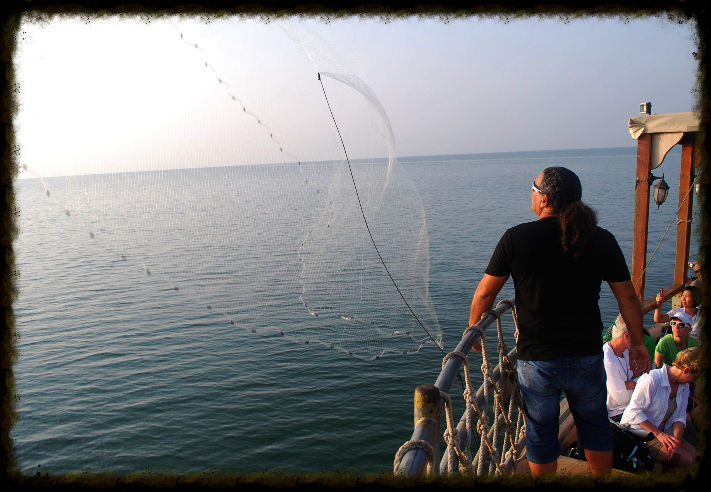COME SAIL WITH US...
ON THE SEA OF GALILEE
Captain Daniel Carmel casts a net on the Sea of Galilee
This is paragraph text. Double click here to edit and add your own text.
The Sea of Galilee: Where Jesus Walked
by Cindy Iglitzen Socianu
"Known by a handful of other names such as Lake
Kinneret, Lake of Gennesaret and the Sea of
Tiberias, the Sea of Galilee has a vibrant history
dating back thousands of years. Straddling the
ancient Via Maris (trade route) that connects Egypt
with the northern empires of the past, this stunning
freshwater lake plays a significant role in Israel's
past, present and future.
Located in the northeast of Israel, seated in the Jordan Rift Valley, the trademark harp-shaped lake is deceiving in its size. In actuality, the Sea of Galilee is quite small, extending approximately 13 miles in length and only about 8 miles at its widest. Having a maximum depth of about 200 feet, it is relatively shallow. [Comparatively Lake Erie shares the same depth, despite being 100 times larger. They also share a similar temperament: due to their size and shallow depth, winds can stir up storms without warning, producing violent waves and putting any vessel at risk. The hospital where I was born is just 5 minutes from Lake Erie, and my dad once worked on the huge Great Lakes shipping vessels. - David ]
The shores of the Galilee are famous as the place where the majority of Jesus’ ministry occurred, most notably recorded in the Gospels of Mark and Luke. Continuous development of settlements attracted thousands to its shores providing Jesus with resources to sustain His work. The Apostles Simon (Peter), Andrew, John, and James were all recruited to become “fishers of men” from the Galilee region. One of Jesus’ most famous teachings, the Sermon on the Mount, is believed to have been delivered on a hill overlooking the Sea of Galilee. Many of His miracles occurred here, including walking on water, calming the storm, the miraculous catch of fish as well as the feeding of 5,000 people in Tabgha.
After years of clashes between Jews and Romans in Judea, the Jewish people revolted against Emperor Hadrian’s oppressive rule. Subsequently in 135 AD, all Jewish people were forbidden to enter Jerusalem. Searching for a new place to call “home,” the center of Jewish learning shifted north to the Galilean region around the sea, particularly to the city of Tiberias. Here the Jewish culture thrived for centuries thereafter.
In the early 20th century, Jewish pioneers established the first kibbutz (farming village) on the sea, teaching agricultural methods to the settlers. After British forces defeated the Ottoman Turks in 1920, a new border between Palestine and Syria was created across the middle of the sea and formalized in 1923. During the 1948 invasion of Israel, the territory along the Sea of Galilee came under Syrian possession until the 1967 Arab-Israeli War.
Today, tourism around the Sea of Galilee plays an essential role in the Holy Land. Attracting many Christian and Jewish pilgrims, the region boasts many noteworthy sites. In 1986, a first-century A.D. fishing boat was discovered on the northwest shore during one of its many record-breaking droughts. Known affectionately as the “Jesus Boat,” the vessel is a striking example of the kind of boat Jesus and His disciples would have used. A popular excursion is a boat ride to the middle of the lake where Jesus walked.
In 2011, Israel unveiled a 40-mile hiking trail named the “Jesus Trail,” following what is believed to be the paths Jesus journeyed during his three-year ministry. Additionally, thousands come yearly to be baptized at the site where the Sea of Galilee’s water flows into the Jordan River.
Visitors to the Sea of Galilee discover a place rich in history and activity. Whether it’s fine dining, fishing, boating, or enjoying miles of quiet beaches and trails far from the breakneck pace of the urban centers, the lake and its tranquil surrounding region are a soothing balm for the mind, body, and spirit."
- Used by permission of my friend Cindy Itlitzen Socianu.
Cindy is Owner/Operator of IsraelAdvantageTours.com.
For 10 years, she was Deputy Director of the Israel Government Tourist Bureau.
"Thank you Cindy - to dah rabah!" - David



